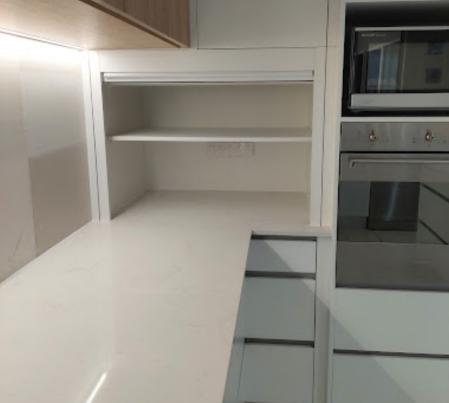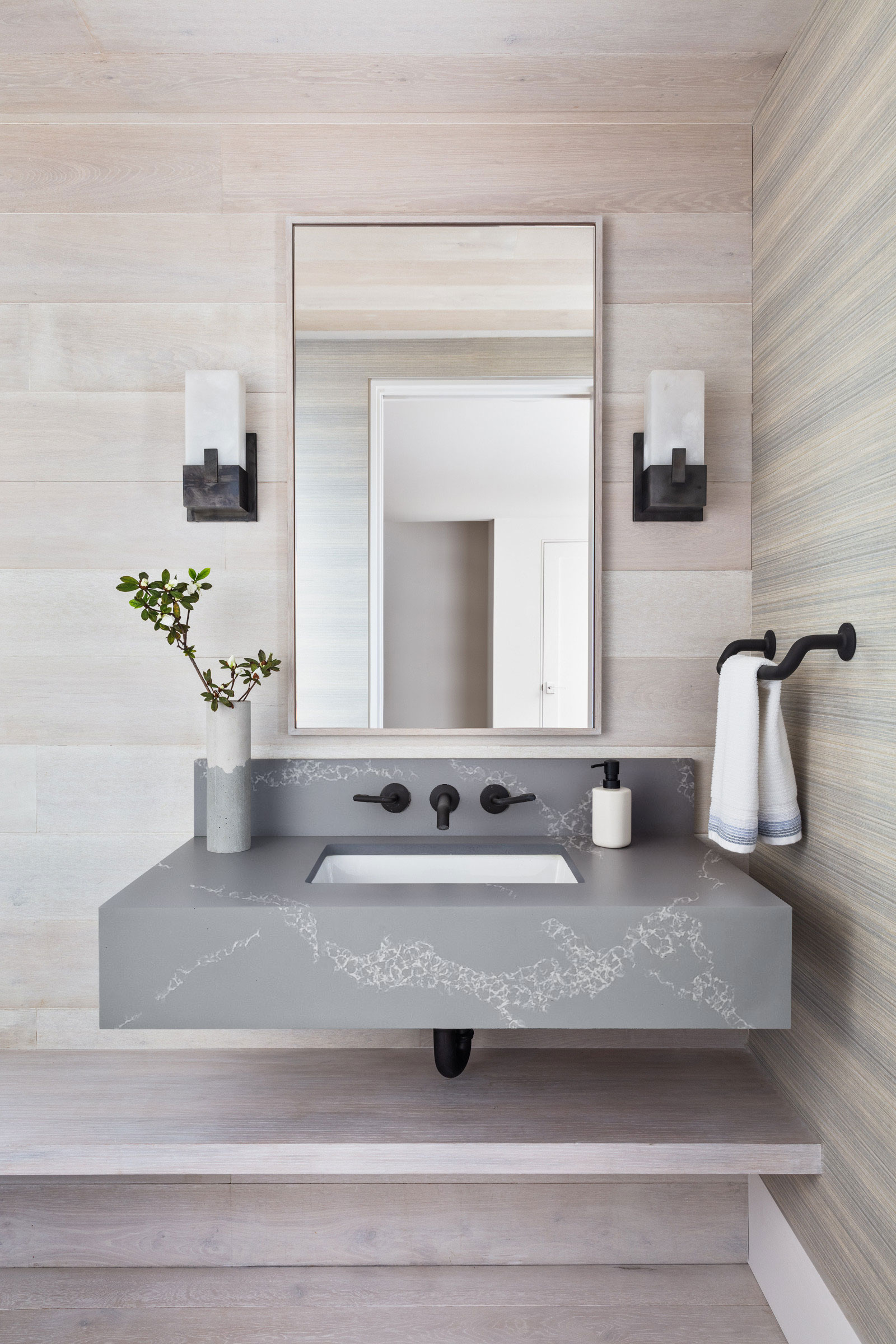

Tape measure (25’+), pencil, and straightedge (aluminum or wood)
Jigsaw with fine-tooth blades (10–12 teeth per inch) for curved cuts; circular saw for straight cuts
Router with a flush-trim bit (for smoothing edges)
Orbital sander (120-, 220-, and 400-grit sandpaper)
Clamps (bar clamps or C-clamps) to secure material
Level (4’+), stud finder, and drill/driver
Safety gear: safety glasses, dust mask, work gloves, and ear protection (for power tools)


Solid surface sheets (cut to rough size—add 2–3” extra for trimming)
Plywood substrate (3/4” thick, birch or plywood rated for moisture)
Construction adhesive (for bonding substrate to cabinets)
Epoxy adhesive (color-matched to your solid surface—critical for seamless seams)
Painter’s tape, denatured alcohol (for cleaning surfaces), and lint-free cloths
Wood screws (1-1/4” for securing substrate)
Map Your Space: Sketch your cabinet layout, noting corners, sink cutouts, and appliance openings (e.g., for stoves or dishwashers).
Measure Cabinets: For each cabinet run, measure the length, width, and desired overhang (typically 1–1.5” over the front and sides of cabinets). Add 1/8” to width measurements to account for slight cabinet misalignments.
Mark the Solid Surface: Lay the solid surface sheet on a flat, protected workspace (use foam boards or old blankets to prevent scratches). Transfer your measurements to the sheet using a pencil and straightedge. For sink cutouts, trace the sink’s template (included with most sinks) onto the material—center it 2–3” from the front edge.
Double-Check: Use your level to confirm cabinets are even. If cabinets are uneven, shim the low spots with wood shims before proceeding—uneven bases cause cracks in solid surface over time.


Disconnect Utilities: Turn off water lines to sinks and power to any under-counter appliances (e.g., garbage disposals). Disconnect hoses and wires, then remove the sink or appliances.
Detach Old Counters: Most counters are secured with screws from underneath or adhesive. Use a utility knife to cut through caulk along the backsplash. For wooden counters, unscrew from cabinets; for stone or laminate, gently pry up with a crowbar (place a wood block under the crowbar to avoid damaging cabinets).
Clean Cabinets: Remove any leftover adhesive or debris from cabinet tops. Inspect cabinets for damage—repair loose hinges or warped wood before installing the new substrate.
Secure the Sheet: Clamp the solid surface sheet to your workspace, ensuring the cut line hangs over the edge (this prevents the material from splintering).
Make Straight Cuts: Use a circular saw with a fine-tooth blade (set the blade depth to 1/4” below the sheet). Cut along your marked line at a slow, steady pace—fast cuts cause melting (solid surface is heat-sensitive).
Cut Curves or Sink Openings: For curves (e.g., sink cutouts), drill a 3/8” hole inside the cut line to insert the jigsaw blade. Cut along the template, keeping the blade straight to avoid jagged edges.
Smooth Edges: Use a router with a flush-trim bit to smooth cut edges. Start with 120-grit sandpaper, then move to 220-grit—this removes saw marks and prepares the surface for bonding.
Cut the Plywood Substrate: Cut 3/4” plywood to match your cabinet dimensions (include overhangs). For sink or appliance openings, cut out the same shape as the solid surface (but 1/2” smaller to avoid interfering with seams).
Attach Substrate to Cabinets: Apply construction adhesive to the top of cabinets, then lay the plywood on top. Secure it with wood screws (drill pilot holes first to prevent splitting) every 8–10” along cabinet studs. Use a level to ensure the substrate is flat—add shims under low areas if needed.
Test-Fit First: Lay the cut solid surface on the substrate to check alignment. Ensure overhangs are even, and sink/appliance openings line up. If adjustments are needed, sand the edges lightly—never force the material into place.
Bond the Countertop: Lift the solid surface and apply a thin, even layer of construction adhesive to the plywood substrate (avoid globs, which cause bumps). Carefully lower the solid surface back onto the substrate, pressing firmly to eliminate air bubbles.
Secure with Clamps: Use bar clamps to hold the countertop in place while the adhesive dries (follow the adhesive manufacturer’s instructions—most take 24 hours to cure). Place clamps every 12” along the edges, using wood blocks between clamps and solid surface to prevent scratches.
Prepare Seam Edges: Sand the edges of both pieces with 220-grit sandpaper until they fit together tightly (no gaps larger than 1/32”). Clean edges with denatured alcohol to remove dust—oil or debris ruins the bond.
Apply Epoxy Adhesive: Mix the color-matched epoxy (follow the manufacturer’s ratio—usually 1:1) and apply a thin layer to one edge. Press the two pieces together, aligning them perfectly.
Clamp and Cure: Use seam clamps (or bar clamps with wood blocks) to hold the seam tight. Wipe away excess epoxy with a lint-free cloth dampened with denatured alcohol—do this within 5 minutes, as epoxy sets quickly. Let the epoxy cure for 24 hours.
Sand the Seam: Once epoxy is cured, start with 120-grit sandpaper to level the seam. Sand in a circular motion, moving outward from the seam to blend it with the rest of the counter.
Smooth the Surface: Progress to 220-grit sandpaper, then 400-grit. For a high gloss, use a polishing compound (specifically for solid surface) with a buffer or orbital sander set to low speed.
Edge Detailing: If desired, round the front edge with a router and a 1/4” radius bit, then sand and polish for a soft finish.
Clean the Surface: Wipe the countertop with denatured alcohol to remove sanding dust. Apply a small amount of solid surface cleaner (or mild dish soap and water) to a damp cloth and wipe down the entire surface.
Reinstall Fixtures: Reconnect the sink, appliances, and water lines. Caulk along the backsplash and sink edges with silicone caulk (color-matched to your counter) to prevent water damage.
Maintain Your Counter: To keep solid surface looking new:
Avoid placing hot pans directly on the surface (use trivets).
Clean stains immediately with a non-abrasive cleaner (avoid bleach or ammonia).
Buff out minor scratches with 400-grit sandpaper and polishing compound.
Related Blogs
-
 Combining Aesthetics and Durability: Solid Surface Stone TrendsPost-pandemic, homeowners are no longer choosing between beauty and resilience for home spaces—and solid surface stone, particularly acrylic variants, hits this sweet spot perfectly.Aesthetically, it’s keeping pace with 2025’s design shi
Combining Aesthetics and Durability: Solid Surface Stone TrendsPost-pandemic, homeowners are no longer choosing between beauty and resilience for home spaces—and solid surface stone, particularly acrylic variants, hits this sweet spot perfectly.Aesthetically, it’s keeping pace with 2025’s design shi -
 Solid Surface Sinks: A Comprehensive Guide to Pros and ConsIn modern kitchen and bathroom design, solid surface sinks have gained a loyal following for their sleek appearance and functional benefits—but they are not a one-size-fits-all solution. Crafted from a blend of acrylic/polyester resins and m
Solid Surface Sinks: A Comprehensive Guide to Pros and ConsIn modern kitchen and bathroom design, solid surface sinks have gained a loyal following for their sleek appearance and functional benefits—but they are not a one-size-fits-all solution. Crafted from a blend of acrylic/polyester resins and m -
 The Unmatched Benefits of Solid Surface Sinks: Elevating Functionality and Aesthetics in Modern SpacesIn the realm of kitchen and bathroom design, the sink is far more than a utilitarian fixture—it’s a central element that balances daily functionality with visual harmony. As homeowners and designers
The Unmatched Benefits of Solid Surface Sinks: Elevating Functionality and Aesthetics in Modern SpacesIn the realm of kitchen and bathroom design, the sink is far more than a utilitarian fixture—it’s a central element that balances daily functionality with visual harmony. As homeowners and designers



















